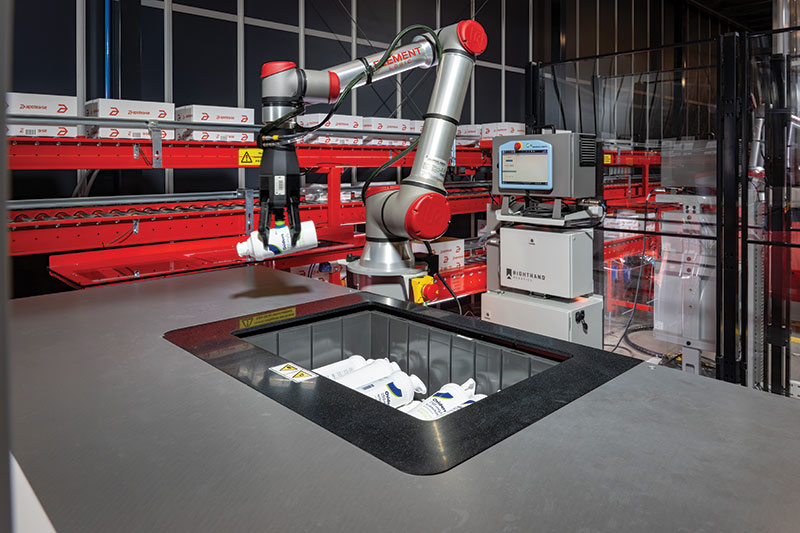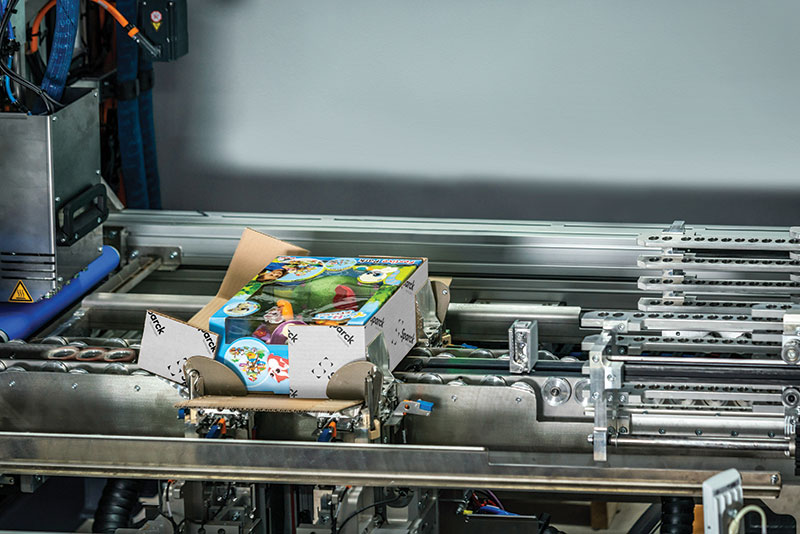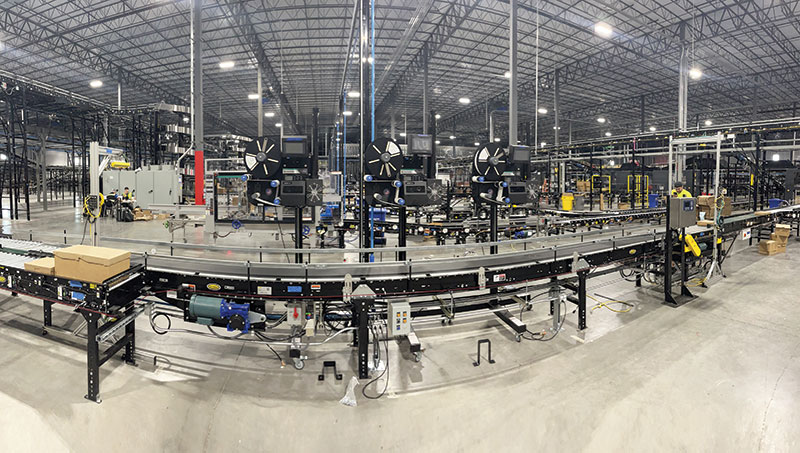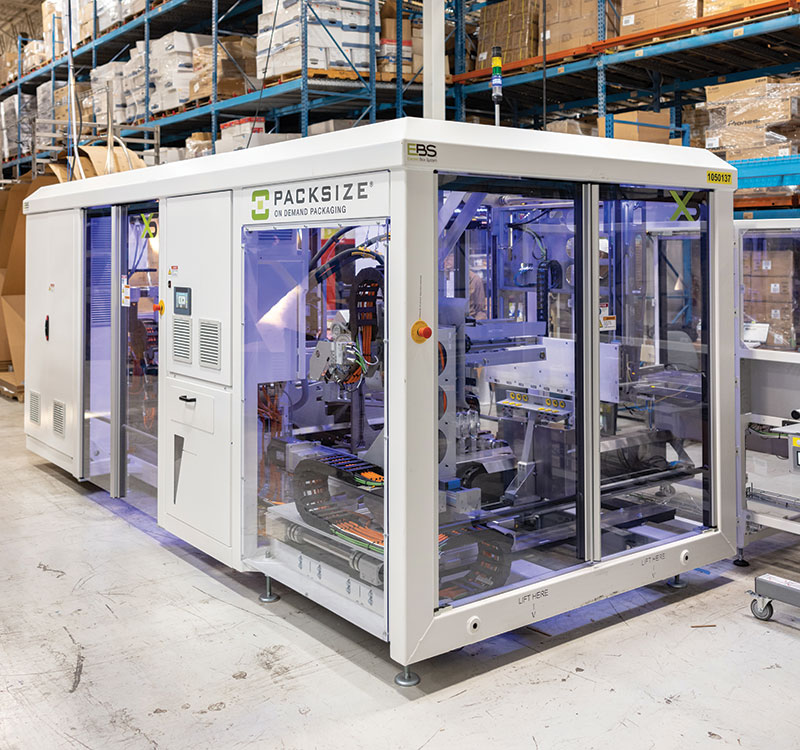Pack out automation: Flexibility on the rise
Providers of automated packaging and carton right-sizing solutions have thrived by offering systems that deliver on labor and parcel shipment savings— now they’re looking to further evolve by looking to use lighter materials and support flexible “box-first” workflows.

The shape of automated packaging solutions is changing to envision more than the rigid inline solutions at the tail end of the material flow. The welcome upshot: more flexibility in how automated packaging systems can be configured to benefit operations.
Instead of automated packaging always happening near the physical end of the process, more suppliers are talking about “box-first” approaches that allow right-sized shipping cartons to be used in upstream picking, cutting down on double handling items versus picking to an intermediate container. Also foreseen is the use of smart robotic picking arms to induct or otherwise assist in automated pack out.
The result is that automated packaging solutions can be quite flexible, while hitting throughput levels that exceed what manual packers and pack stations can do, especially without having to scramble a large team of packers each shift to hit cut-off times.
A range of approaches is driving this flexibility. Besides specialist automated packaging vendors, integrators and consultants offer automated scan, label, apply and manifest (SLAM) solutions. At the same time, packaging automation vendors that offer carton right-sizing are looking to use lighter materials to create a stronger sustainability case for shipping lightweight items in cartons rather than bags. Meanwhile, some autobagging solution vendors now offer machines that produce curbside recyclable bags.
These trends create more choices, but flexibility, when it comes to automating core fulfillment workflows like pick, pack and ship, is a good thing. Marco-trends like persistent labor challenges in warehousing help shape demand for packaging automation, notes Christian Lancaster, senior specialist for innovation and design at St. Onge Company, a supply chain consulting firm.
“Though the U.S. unemployment rate has been at historic lows since the beginning of this year, there is still a worker shortage in materials handling roles,” Lancaster says. “This is putting pressure on companies to find enough workers to perform needed tasks, and as a result, many companies are looking at automation to improve overall efficiency and address labor gaps. We’re also seeing that packaging automation can provide corporate environmental benefits with solutions that improve sustainability or reduce carbon footprint.”
Speed and output
A central benefit of automated packaging solutions is speed versus manually packing small orders. Just how fast depends on how efficient the previous manual process was and the level of automated packaging machinery being deployed.
Some automated solutions will also create a “right-sized” carton from corrugated stock, wrapping a customized carton around the shape of the specific items being inducted into the system.

That right-sizing drives a host of benefits, from less spend on materials, to significant savings in parcel shipping fees, because compared to standard box sizes, the shipper isn’t paying carriers to transport empty void space in packages.
For users of solutions from Spark Technologies, which offers right-sized automated packaging, the average labor savings versus manual processes is an average of 88%, says Sean Webb, director of sales and service in North America.
“The labor efficiency gains can vary relative to what they’ve implemented before and how efficient they’ve tried to be in the past, but the labor savings can be substantial. For instance, if an operation had 10 people do all the packing and labeling and other steps in a manual process, you can often bring that down to two people with automation. The other big area of benefit is transportation, because once you right-size that box and remove the excess volume and material from what you’re shipping, that directly impacts transportation cost.” - Webb
A 32% average reduction in parcel shipping is common with Sparck’s solutions, Webb adds, which for high volume operations that rack up large parcel shipping costs can slash a major area of spending by nearly a third.
Other advantages to automated packaging with autoboxing technology include less damage (due to less rattling around of goods in transit), less spend on void fill, and a tidier, less wasteful presentation for end-consumers, who aren’t going to find their items swimming in an oversized carton alongside void fill materials, adds Webb.
“For many consumers, they want to see that the brands they’re ordering from are caring about the environment, so sustainability becomes a driver within that unboxing experience,” says Webb.
For future directions, adds Webb, Sparck is looking to develop solutions to support a “pick-to-box” method, which might be an efficient approach for operations using technologies like autonomous mobile robots (AMRs) in upstream picking operations.
“Largely, our models have been focused on applications in which the order items are picked to a tote, and then those items are brought to our system, where the right-sized box is created toward the end of the process. But there are a lot of applications where the operation may want to build the right-size box earlier on in the work process, and we’ve got some new technology that’s going to be coming out to address that need.” - Webb
Another benefit for solutions that incorporate dimensional scanning and weighing (part of SLAM) is that they reduce carrier chargebacks by shipping based on accurate weights and dimensions captured on the SLAM line, rather than master data that may not be accurate, says Dennis Andre, director of automation with enVista Corp., a supply chain consultancy and automation integrator that offers SLAM solutions.
On top of that, the consistent application of labels from SLAM’s print and apply element tends to reduce chargebacks from customers for incorrect label placement.
“Depending on how many chargebacks an operation is getting, the reduction in chargebacks can be a major area of payback, though at the end of the day, the return on investment for SLAM solutions tends to be driven by the enhanced speed of having an automated process and the labor time you’re able to save,” Andre says.
A SLAM line with a single label applicator can crank out 20 to 30 packages per minute with a single person running the line, says Andre, and higher yet with multiple applicators on a line or multiple SLAM lines in the DC. That level of efficiency can help remove the late shift bottlenecks that can occur under manual processes.
“Sometimes companies will adopt SLAM automation because they see chargebacks and shipping costs really going up, and other times companies will stick with manual processes until they simply get to the point where they cannot do it fast enough with available workforce,” says Andre. “The speed of the SLAM line can ensure an operation will get packages out the door fast enough.”
More flexibility, please
SLAM line solutions can be customized to site needs or organizational preferences, adds Andre. For example, some companies may prefer a certain parcel shipping software to support rate shopping during manifesting.
Others may build in a quality control step if the real-time weighing and dimensioning data differs from master data for the items in an order.
While automated pack out often occurs at the end of a DC’s material flow, automated equipment that creates right-sized cartons can support “box-first” methods in which cartons are built to fit incoming orders, and then those boxes are used upstream to pick directly to the right-sized carton, says Steve Larsen, vice president of global strategic partners and customer solutions for Packsize, which offers “on-demand” carton right-sizing solutions.
For some operations, Larsen adds, picking into a right-sized carton is a way of reducing touches versus picking to an intermediate tote. Though for high-volume operations, a box-last approach with other automation functions integrated into the line like weighing and labeling can be a better fit.
“We see a lot of companies focused on touch reduction,” Larsen says. “They’re very interested in driving down the number of touches that are part of their process, and we can play a role in box-first carton creation to reduce or eliminate touches.”

customizing the solution to site needs when it comes to functions like how many label applicators there should be.
Larsen says Packsize’s software can integrate with warehouse management systems (WMS) or warehouse execution systems (WES) or control systems to create cartons that suit incoming orders. Some operations may prefer a box-last approach, though with a box-first method, says Larsen, there is potential to reduce touches during pick/pack processes in many DCs.
To expand the range of lighter weight products suitable for shipping in cartons rather than bags, Packsize is exploring equipment that can create small cartons from lighter weight materials. Rather machines built to create cartons from heavier duty 44C corrugate board.
“We want to partner with our customers and those in the industry to identify how we continue to drive down or right-size the grade of material for the cartons you’re shipping,” says Larsen. “We want to get to a state where the utilization of the materials better matches the range of goods being shipped. We see great opportunities to make advancements in this area.”
Robotics edges in
Like other advanced automation, packaging systems, even advanced in-line solutions, aren’t completely lights out. Human operators are needed to verify and induct items into an automated packaging line or autobagging equipment. Now robotic picking software platforms that leverage technology like vision and artificial intelligence are making it possible for robotic arms to lend a hand with induction.
David Schwebel, head of sales and strategic business development for RightHand Robotics, which offers robotic piece picking software, notes that RightHand’s RightPick platform has already been used to pick and place goods into shipping cartons and to induct goods into autobaggers.
While RightHand doesn’t have formal alliances with automated packaging solution vendors just yet, Schwebel says there’s interest among integrators, end users and subcomponent vendors in seeing how smart robotics could help bring further efficiencies to packaging processes.

“In general, aligning robotic piece picking with packaging machinery is being openly discussed right now,” says Schwebel. “We have multiple next-step vendors we’re talking with.”
Smart robotic picking stations can pick and place from one spot of space to another, which opens up various possibilities in terms of packaging. This enables a robotic picking arm, for example, to pick items from a bin coming out of an AutoStore automated storage system and place those items into outbound shipping cartons.
One of RightHand’s customers Apotea, a large online pharmacy based in Sweden, has deployed this very process: picking from items in a tote being retrieved from an AutoStore cube storage system and placing them into Apotea-branded shipping cartons, notes Schwebel. The RightHand software communicates with execution software from AutoStore integrator Element Logic as part of this deployment.
Essentially, says Schwebel, RighHand’s technology is flexible in terms of where to “place” items. As a result, a robotic arm powered by RightHand’s software can pick goods from an automated storage and retrieval system (AS/RS) and drop the items in a shippable carton or do another packaging-related task like take goods from an order tote and place them into an autobagger, or induct items into an automated packaging line.
Or, for some slower moving goods that don’t suit an AS/RS, an operation may want to have a robotic pack out area where a robotic arm could pack out orders from totes brought to it from an assistive pick AMR system or a manual pick-to-cart workflow.
Ultimately, there is no single way pick-and-place robotics will support automated packaging, but rather, multiple potential use cases, with the application driven by customer needs or the gaps to be filled between existing systems and manual processes, Schwebel says.
“We are finally hearing that education is turning into the potential for adoption,” says Schwebel. “It all comes down to what the customer needs to process their specific products and importantly, not constraining their systems in terms of adapting to future growth and change.”
It will take more time to see widespread use of smart robotics as part of packaging automation, cautions Schwebel, but this merging promises to bring further labor savings for operations and would free up human labor to concentrate on more complex tasks like quality control or exception management that humans are good at, rather than take humans out of every fulfillment workflow.
“Robots have that ability to be that gap filler between systems and processes that involve some human support, augmenting the workforce by taking on the highly repetitive tasks that robots do well, so humans can focus on the fuzzy, more complex tasks we excel at,” says Schwebel.
Lancaster concurs there is interest in using smart robotics to assist in pack out and other processes, but advises caution in assuming automation can be universally applied across all SKUs.
“Automation could be a step worth exploring, but it’s important to keep in mind that an automated solution may only be effective for a limited SKU set or a specific workflow,” Lancaster adds. “In general, solutions should look at incorporating efficient automated processes where applicable and supplementing with flexible manual processes where necessary.”

Article Topics
RightHand Robotics News & Resources
RightHand Robotics rolls out next-generation RightPick system RightHand Robotics signs multi-year agreement with Staples to deploy AI-powered picking robots Pack out automation: Flexibility on the rise Time to integrate those robots Robotic applications at ProMat 2023 RightHand Robotics appoints Brian D. Owen as new CEO with a focus on growth For piece picking, it’s all about timing More RightHand RoboticsLatest in Materials Handling
Geek+ and System Teknik deploy PopPick solution for pharmacy group Med24.dk Beckhoff USA opens new office in Austin, Texas Manhattan Associates selects TeamViewer as partner for warehouse vision picking ASME Foundation wins grant for technical workforce development The (Not So) Secret Weapons: How Key Cabinets and Asset Management Lockers Are Changing Supply Chain Operations MODEX C-Suite Interview with Harold Vanasse: The perfect blend of automation and sustainability Consultant and industry leader John M. Hill passes on at age 86 More Materials HandlingAbout the Author
Subscribe to Materials Handling Magazine

Find out what the world's most innovative companies are doing to improve productivity in their plants and distribution centers.
Start your FREE subscription today.
April 2024 Modern Materials Handling

Latest Resources










